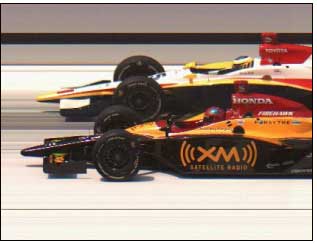To time and score Sunday’s Indianapolis 500, the event’s sanctioning body used an RFID-based system called TranX Pro. Made by AMB i.t. of Heemstede, Netherlands, the transponder-based, automatic identification and timing system is used by professional sports organizations worldwide to time and score everything from IndyCar racers to the Olympic Games.
The detection loop is connected to an AMB TranX Pro trackside decoder (TSU) that reads the ID code and creates a record of the car’s passing. That information is sent through a fiber optic cable in TCP/IP Ethernet mode to the control tower, where two AMB servers running customized AMB Track Timing TimeGear MultiLoop software collect the records and update the race order.
A customized AMB software module then writes each record to a database file. IRL-created software retrieves the information and distributes it via the IRL’s Microsoft SQL Server 2003 database application called Indy Racing Information Systems (IRIS). Running on an HP Proliant DL 380 server, IRIS presents real-time lap-by-lap timing and scoring results to IRL race teams, officials and the media, as well as fans via scoreboards around the 750-acre motor sports complex.
The Speedway’s Online Team’s network also continuously taps IRIS to post ongoing race results live to the Internet. Fans worldwide can get real-time updates of the lap-by-lap scores throughout the 500-mile race via www.Indy500.com. The Web site received more than 300 million hits during May 2003, according to Adrian Payne, manager of Internet development for the Indianapolis Motor Speedway.
Although the AMB TranX Pro system is the IRL’s core timing system, the IRL, like the NFL, NBA and other professional sports leagues, also depends on highly experienced human observers to officiate the 500. In fact, AMB strongly recommends all its customers use visual verification of finishes of competitors closer than 6/10,000ths, Oonk says.
In addition to a team of observers, IRL Timing and Scoring uses TAG Heuer electronic photocells and other auxiliary timing systems for additional checkpoints. A new high-speed digital finish-line and timing camera, provided through a technology partnership with TAG Heuer, was added this year to document every passing of every car throughout the race.
Focused on the start-finish line, the camera takes a frame every 1/10,000th of a second—fast enough to freeze tire rotation as cars pass at 200 mph. The resulting image is so crystal-clear that you can even read the Indianapolis Motor Speedway’s wing-and-wheel logo on the Firestone tires.
“This isn’t a photo-finish camera that takes one photo of the finish,” Koskey says. “This camera documents the entire 500-mile race and provides us with excellent digital video evidence of every passing of every car.”
Koskey says technology is one of the reasons the IRL is the leader in motor sports entertainment, but there’s a more pragmatic reason the IRL uses AMB’s TranX Pro System. Race officials use the information generated by the timing system to tell the race promoter how to divide the purse. Though the exact amount will not be disclosed until Monday evening’s 500 award banquet, first-place finisher Buddy Rice of Phoenix will win more than $1 million. Last year’s winner Indy 500 winner, Gil de Ferran, took home $1,353,265 of the record $10,151,830 purse.
Attend RFID Journal University
There are less than two weeks left
until
RFID Journal University
in
the Washington, D.C., area. This unbiased educational course, presented
by
RFID Journal and members of Auto-ID Labs, is designed to provide
the
fundamental understanding of RFID needed to begin a successful pilot.
Register
today, or
to learn more, visit RFID
U.


